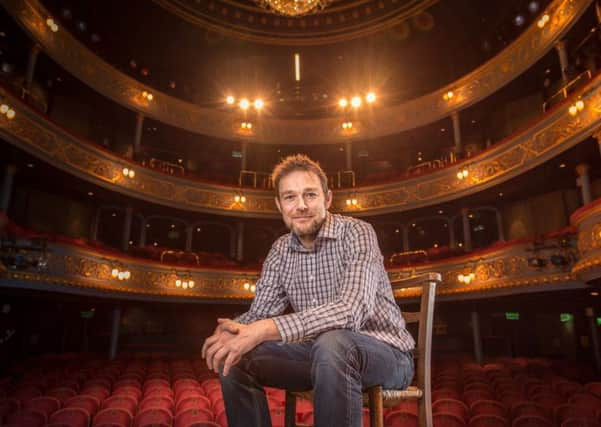Theatre interview: David Greig on Local Hero, Touching the Void and the rest of the Royal Lyceum's 2018/19 season


The first thing to notice about the 2018-2019 programme announced last week, therefore, it’s that it contains fewer new shows than last year’s season – six compared with nine – but that two of them are on a truly epic scale. Scheduled to play one after the other early in 2019, Greig’s stage adaptations of the Joe Simpson climbing memoir Touching The Void, and of Bill Forsyth’s legendary 1983 film Local Hero – with Forsyth co-writing the stage version – are both huge projects for the Lyceum, the first co-produced with Bristol Old Vic, the Royal & Derngate Theatres in Northampton, and Kate McGrath’s London-based production company Fuel, and the second with the Old Vic in London. Directed by Irish film and theatre director John Crowley, with music by Mark Knopfler based on the original film score, Local Hero will run at the Lyceum for a full month after its world premiere there next March, will transfer to the Old Vic, and should have a continuing life after that.
Beyond these two blockbusters, the season also includes a new Seventies-styled Twelfth Night from director Wils Wilson – who so brilliantly created last autumn’s unforgettable Lyceum production of Bridget Boland’s Cockpit – and a chance for Lyceum audiences to enjoy the Citizens’ new production of Edwin Morgan’s Scots version of Cyrano De Bergerac, co-presented with the Lyceum and the National Theatre of Scotland; and, at Christmas, a new version of Peter Pan by Ella Hickson, one of the young rising stars of British playwriting.
Advertisement
Hide AdIn spring – after her thrilling successes with Rhinoceros and This Restless House – Zinnie Harris will adapt and direct a new version of John Webster’s stunningly radical Jacobean tragedy The Duchess of Malfi, about a female leader crushed by the men around her; and this August, there will also be a Fringe revival of last autumn’s hugely popular studio hit Love Song To Lavender Menace, James Ley’s play about Edinburgh’s legendary gay bookshop of the 1980s.
So what does the shape of this season tell us about the state of the Lyceum, and of Scottish theatre, in spring 2018? In the first place, it still reflects the aftershock of Creative Scotland’s decision, back in 2014, to cut the Lyceum’s grant by 17 per cent over the next three years; for although that cut was reversed in the controversial new funding round earlier this year, this season was conceived and planned around the possible continuation of seriously cash-strapped times.
“Every new show on this list, except the Christmas show and The Duchess of Malfi, is a co-production with another company or companies,” says David Greig. “And the fact that we and other companies are increasingly dependent on co-productions reflects a general level of stress in our producing theatres, the result of what has effectively been 15 years of standstill funding. And every time two theatres co-produce, that marks a reduction in the number of new shows being made. A few years ago, I would have said there would always be a thriving theatre production scene in Scotland, enough to support some kind of career for young theatre workers, whether they’re writers or actors or designers or whatever; now, I’m not so sure, and I think a lot of gifted young theatre workers have just gone in the last few years, mainly to London.”
Greig’s response to this dangerous moment in Scotland’s theatre life, though, is not to retreat and retrench, but to move forward, and think big about how Scotland’s larger theatres can boost their own income, in particular by winning a share of the UK large-scale touring market. Hence the collaboration with theatres like the Old Vic and the Royal & Derngate, one of Britain’s leading producers of successful touring shows.
“There are dangers in this of course,” says Greig. “Where you’re pitching towards an audience 90 per cent of which is not Scottish, there is pressure on the repertoire you can work with. But it’s been a hard learning experience for me that we can produce world-class shows here in Scotland – This Restless House, Rhinoceros, even our 2015 version of Lanark – and they can attract a great deal of UK and international interest; but unless we have producers outside Scotland involved from the outset, we have very little chance of giving them much further life.
“So part of my response to that is to look for Scottish stories that are big and brilliant and Scottish and universal, and Local Hero is all of that. It’s through shows like this that we can win the resources to take
Advertisement
Hide Adthe risks we want to take, especially with new work – because at the moment, most building-based theatres in Scotland are just one bad box-office flop away from real financial trouble. So this season is about beginning to develop that, as well as about the pure pleasure of working with artists like Zinnie Harris, who are just on a roll, and doing great things. In that sense, it’s especially exciting; and I think we can make it work.”
The Royal Lyceum’s 2018-19 season runs from 14 September until June next year